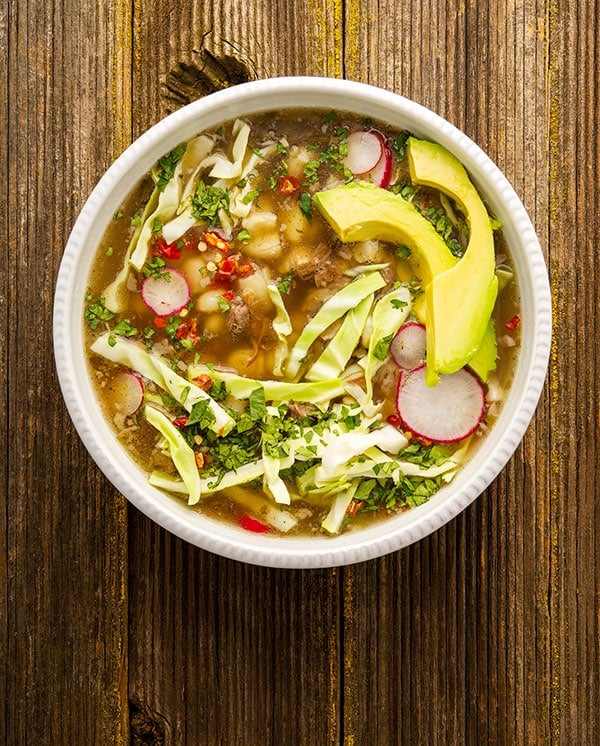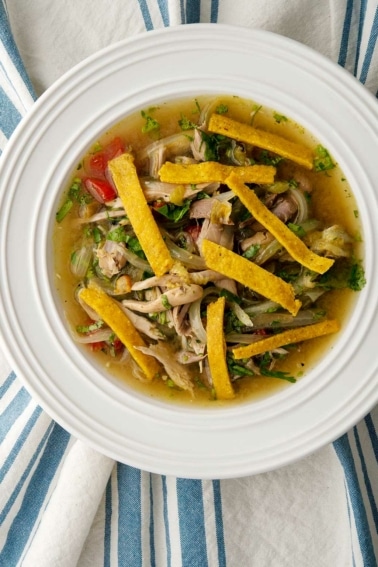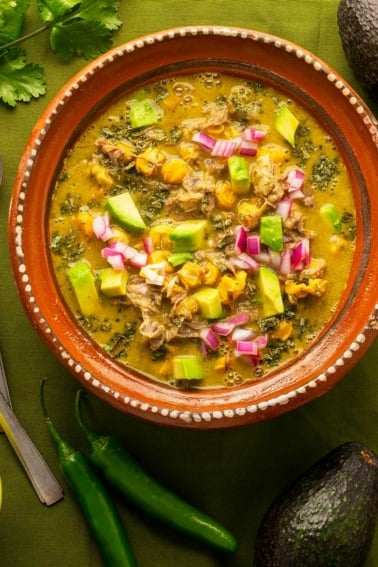As an Amazon Associate I earn from qualifying purchases.

White pozole, pozole blanco, is a specialty of the Mexican state of Guerrero, and is considered by some the purest of all pozoles.
Unlike my recipes for pozole verde and pozole rojo, this version represents the third color of the Mexican flag — and yes, a galaxy of dishes a la bandera, like the flag, exists in Mexico.
The beauty of pozole blanco is its purity: Nothing can distract you from the broth, which is the star here. Yes, it is designed so you can add green or red salsa to your bowl, making this soup something of a dealer’s choice, but I prefer it clear, with lots of dried chiltepin chiles crushed into it.
In a perfect world, you would nixtamalize your own corn, nip off the root end of each kernel, and simmer that with a pig’s head. This is what I did. Why is this the perfect base for pozole? Because this is how it’s been made, more or less, for centuries in Mexico.
The freshly nixtamalized corn (here are my instructions on how to make nixtamal) tastes so much better than either canned hominy or dried, pre-nixtamalized corn, that it’s hardly the same soup.
But I get it: Not everyone is going to go for this. Your preferred alternatives would be 1) dried, pre-nixtamalized corn, and 2) canned hominy. The first is available through that link, the second in most supermarkets. Sweet corn is not a substitute.
As for the pig’s head, it has meats of varying flavor and color, and there is so much collagen in it that the broth will set up like jello in the fridge; this is a good thing, because that collagen lends heft and body to the broth. You simmer the pig’s head with the corn until the meat wants to fall off. You then fish it out and strip the meat off, chopping the weirder bits small and leaving the obviously meaty bits large.
Again, I get it. Not many of you are going to go looking for a pig’s head to make pozole blanco. So barring that, buy pork shoulder plus a couple pig’s feet, which are available in many markets. If you can’t get pig’s feet, the world won’t end, but your pozole won’t be as good. Like the head, you simmer the feet until tender, fish them out and chop the meat and skin up small.

You can of course make pozole blanco with chicken, or any other white meat bird, like pheasants or turkey. If you do, try to get some chicken feet from the market for that collagen. Or, go for poultry + pig’s feet.
I am obsessing on the meat and corn here because that is the soul of pozole: Everything else is jazz.
A typical pozole blanco in Guerrero will have onions and garlic, plus bay leaves and Mexican oregano in the broth, and often some allspice berries, cloves and black peppercorns. Super simple.
Then, when you serve it, everyone can add whatever they like to their pozole. Common toppings include: limes, shredded cabbage, sliced radishes, avocado, pickled white onion, cilantro and dried hot chiles.
One other thing. If you want, you can add a salsa to your bowl to make it red or green. If you do, my recommendation is my tomatillo salsa verde.
Pozole Blanco
Ingredients
POZOLE
- 2 pounds dried field corn, nixtamalized (or two 30-ounce cans of hominy)
- 1 pig's head, (or 4 pounds pork shoulder and 2 pig's feet)
- 1 tablespoon Mexican oregano
- 3 bay leaves
- 6 whole cloves
- 10 allspice berries
- 15 whole black peppercorns
- 1 large white onion, chopped
- 8 cloves garlic, sliced thin
- Salt
TOPPINGS
- 6 limes, halved
- 1/4 head cabbage, shredded
- 2 avocados, sliced
- 6 radishes, sliced
- 1/2 cup chopped cilantro
- Dried hot chiles to taste
Instructions
- Submerge the pig's head in water. If you are using dried corn, add it now. If not, wait a while. Bring this to a simmer, and skim off any froth that accumulates. When the froth subsides, add the remaining pozole ingredients and keep the pot at a simmer. If you are using the pork shoulder and feet, it's the same procedure.
- If you are using freshly nixtamalized corn or canned hominy, add it after the pork has been simmering for 1 hour. Continue to simmer everything until the meat wants to fall off, or the shoulder meat can be shredded easily. This will take longer for a head than pork shoulder.
- If you are using the head, fish it out and strip off all the meat; discard the skull. If it had its tongue, peel that and chop roughly. The rule of thumb with a head is to chop recognizable meat rough, everything else fine. If you are using the shoulder and feet, fish out the feet and discard the bones, then mince everything fine. Regardless, once it's chopped, return all the meat to the pot. OPTIONAL: Once the head is out of the broth, I try to pick out the bay leaves, cloves, allspice berries and peppercorns. This makes the soup easier to eat later, but if you miss a few, it's not a big deal.
- Once the meat and corn are tender, you are ready to rock. Lay out all the toppings, and let people mix and match as they like.
Notes
Nutrition
Nutrition information is automatically calculated, so should only be used as an approximation.






Your recipe is the most authentic Mexican pozole Blanco!!!! Bravo ?
Thanks Hank, made this tonight with freezer pig head stock and some of the leftover meatier sections along the belly I’d saved from a butchering. I’ve made red and green pozoles but had never tried a white one; the warm spices you included are really perfect for a winter’s night. Much appreciated.
I love this! Pozole is a dish my Dad and I banter back and forth about as we have both altered his Mexican mommas recipe. She used both pork and beef in hers. My dad disputes my use of green bell peppers ( he hates them all the way around). But my last batch I decided to can a few quarts after mixing it up and before it really got into a good simmer…and it turned out fantastic! Nothing better than a fast bowl of Pozole. Got all your books and a few for my kids. Thanks!!
Big Pazole fan – but haven’t enjoyed it since I left AZ 30 years ago. Interesting fun fact (I am told) Pazole dates back to the Aztecs who traditionally used human flesh to celebrate a conquest of an enemy village. But this repulsed the Spanish who forbade this practice. After that they began to use Pork because (supposedly) “Pork is the closest tasting thing to human flesh!” – I won’t be offended if you don’t post this – LOL… but I just had to share it with someone who is also a Pazole fan.
Todd: I go into that history in the headnotes of my pozole rojo recipe, actually!
I really hope all these recent dishes means you’re putting together a new Central and South American cookbook. I would buy a bazillion copies.
You mean a Brazilian? 😉
But seriously, can’t wait to give it a try. Never been disappointed by Hank’s recipes. I love that they are often simple and always delicious!!
This looks delicious. In NM, where I grew up, we make white posole with lots of Chile piquin, but the toppings are more like the ones for posole rojo (including red Chile caribe sauce that a lot of folks will stir in). In NM we’re really lucky in that most of the big grocery stores carry nice frozen fresh posole around the holidays! I’ve never found it outside the state, though. The company Bueno makes it, I think….
Lynda: Good to know, and it is also very New Mexican to spell it posole, with an “s,” too. In Mexico it is spelled with a “z.” 😉
Thanks, Hank. Your posts are beautiful, elegant, respectful of the creatures we catch or kill, and wonderful tutorials for those of us who never want to stop learning ways to make our families go “M-m-m-m” and smile.